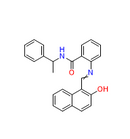Description
Sirtinol, CAS No. 410536-97-9, is a SIRT inhibitor. Sirtinol significantly increased the acetylation of p53, which has been reported to be a target of SIRT1/2. Sirtinol significantly increased the G1 phase of the cell cycle.
Product information
CAS Number: 410536-97-9
Molecular Weight: 394.47
Formula: C26H22N2O2
Synonym:
Sirtinol
2-[(2-Hydroxynaphthalen-1-ylmethylene)amino]-N-(1-phenethyl)benzamide
2-{[(2-hydroxy-1-naphthyl)methylene]amino}-N-(1-phenylethyl)benzamide
(E)-2-((2-hydroxynaphthalen-1-yl)methyleneamino)-N-(1-phenylethyl)benzamide
2-[[(Z)-(2-oxonaphthalen-1-ylidene)methyl]amino]-N-(1-phenylethyl)benzamide
2-[(E)-[(2-hydroxynaphthalen-1-yl)methylidene]amino]-N-(1-phenylethyl)benzamide
2-[(2-oxo-1-naphthalenylidene)methylamino]-N-(1-phenylethyl)benzamide
Sir Two Inhibitor Naphthol
2-[(2-oxonaphthalen-1-ylidene)methylamino]-N-[(1R)-1-phenylethyl]benzamide
AK-16605
Probes1_000047
Probes1_000316
Probes2_000084
Probes2_000518
Oprea1_639422
CBDivE_000728
ARONIS007637
SCHEMBL2543371
SCHEMBL8227466
Sirtinol, >
=95% (NMR)
CHEMBL380797
FT-0644594
S-5353
HY-13515
BR-16605
DS-0089
Chemical Name: 2-[[(2-Hydroxy-1-naphthalenyl)methylene]amino]- N -(1-phenylethyl)benzamide
Smiles: CC(NC(=O)C1=CC=CC=C1N=CC1=C(O)C=CC2=CC=CC=C21)C1C=CC=CC=1
InChiKey: UXJFDYIHRJGPFS-WPWMEQJKSA-N
InChi: InChI=1S/C26H22N2O2/c1-18(19-9-3-2-4-10-19)28-26(30)22-13-7-8-14-24(22)27-17-23-21-12-6-5-11-20(21)15-16-25(23)29/h2-18,29H,1H3,(H,28,30)/b27-17+
Technical Data
Appearance: Solid Power
Purity: ≥98% (or refer to the Certificate of Analysis)
Solubility: Soluble in DMSO, not in water
Shipping Condition: Shipped under ambient temperature as non-hazardous chemical or refer to Certificate of Analysis
Storage Condition: Dry, dark and -20 oC for 1 year or refer to the Certificate of Analysis.
Shelf Life: ≥12 months if stored properly.
Stock Solution Storage: 0 - 4 oC for 1 month or refer to the Certificate of Analysis.
Drug Formulation: To be determined.
HS Tariff Code: 382200
How to use
In Vitro:
Sirtinol reduces the growth of MCF-7 cells in a concentration- and time-dependent manner. The IC50 values of sirtinol are 48.6 μM and 43.5 μM after 24 and 48 h of treatment, respectively. Sirtinol significantly decreases SIRT1 expression and increases the acetylated p53 level. Sirtinol attenuates the proliferation and induces apoptosis of nonsmall cell lung cancer (NSCLC) H1299 cells and causes the significantly increased level of FoxO3a, a proapoptotic transcription factor targeted by Sirt1.
In Vivo:
Sirtinol has anti-inflammatory effects through direct inhibition of HNE activity and attenuates HNE-induced and LPS-mediated tissue or organ injury.
References:
- Kwak SS, Jeon Y, Yoon JD, Cheong SA, Lee E, Hyun SH. 37 the effects of a class iii histone deacetylase inhibitor (sirtinol) on early development of porcine cloned embryos. Reprod Fertil Dev. 2012 Dec;25(1):166. doi: 10.1071/RDv25n1Ab37. PubMed PMID: 23244871.
- Wang J, Kim TH, Ahn MY, Lee J, Jung JH, Choi WS, Lee BM, Yoon KS, Yoon S, Kim HS. Sirtinol, a class III HDAC inhibitor, induces apoptotic and autophagic cell death in MCF-7 human breast cancer cells. Int J Oncol. 2012 Sep;41(3):1101-9. doi: 10.3892/ijo.2012.1534. Epub 2012 Jun 26. PubMed PMID: 22751989.
- Wang TT, Schoene NW, Kim EK, Kim YS. Pleiotropic effects of the sirtuin inhibitor sirtinol involves concentration-dependent modulation of multiple nuclear receptor-mediated pathways in androgen-responsive prostate cancer cell LNCaP. Mol Carcinog. 2012 Apr 11. doi: 10.1002/mc.21906. [Epub ahead of print] PubMed PMID: 22495798.
Products are for research use only. Not for human use.
Payment & Security
Your payment information is processed securely. We do not store credit card details nor have access to your credit card information.


